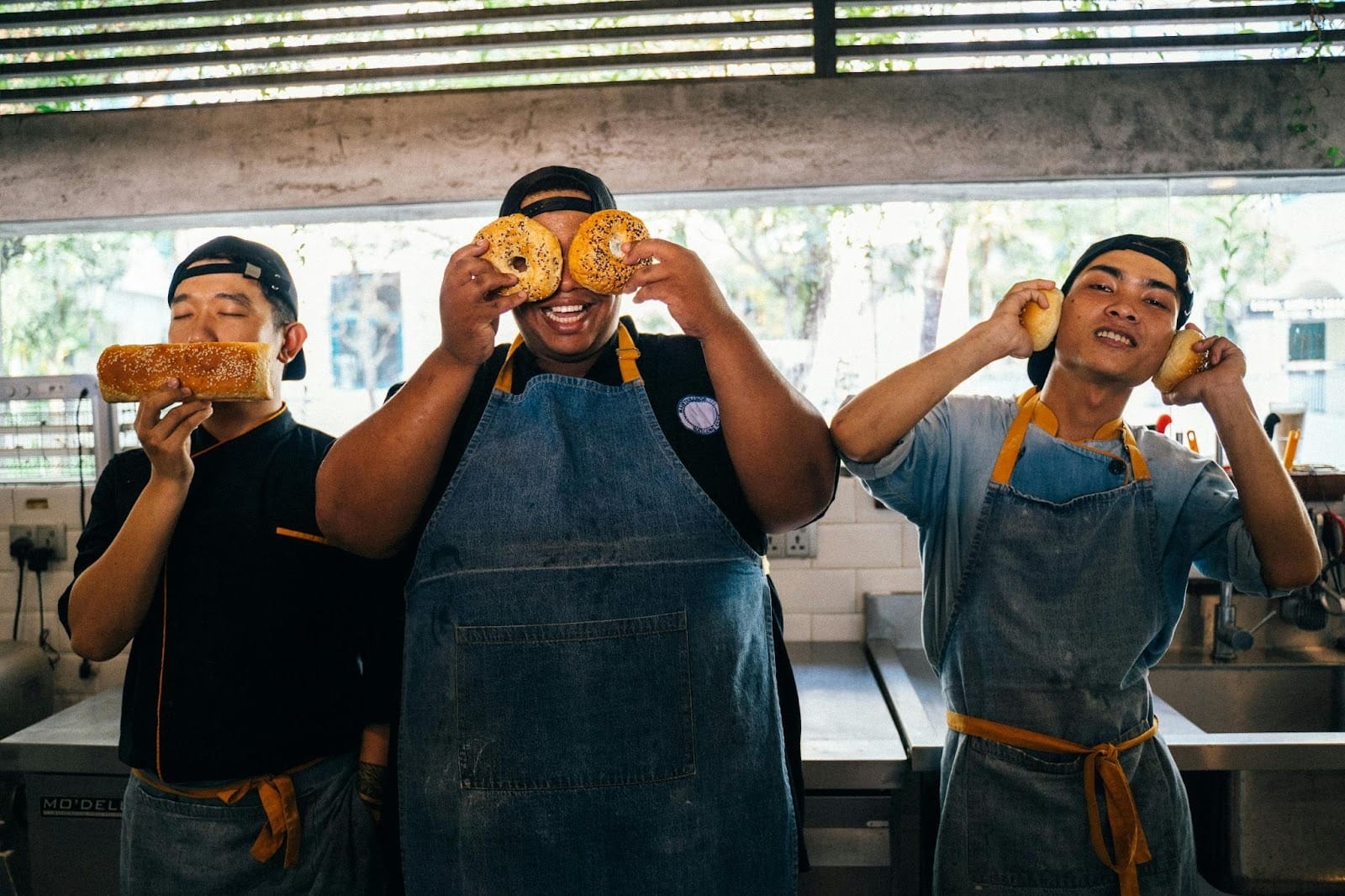Recent research from UK charity Hospitality Action’s Mental Health and Wellbeing survey revealed that 62% of junior hospitality employees believe burnout is just part of the job.
If left unaddressed, burnout and poor staff wellbeing can lead to low productivity, high staff turnover, and recruitment challenges. When the younger generations value a healthy work-life balance, the ‘guaranteed’ burnout in hospitality certainly won’t encourage them.
Managers should shift to prioritising staff wellbeing in hospitality and look at ways to reduce stress to help combat burnout and lower retention. But how?
What causes burnout in hospitality?

Long, unpredictable hours and a constantly fast-paced environment are naturally tiring. Combine that with financial strain, a poor work-life balance, and the ‘service with a smile’ expectation, and you’ve brewed the perfect concoction for burnout.
1. Under-resourcing & understaffing
2. High expectations & excessive workloads
3. Concerns over work-life balance
These aspects, on top of the existing physical, emotional, and mental demands on hospitality workers, only add to the drain on their wellbeing and more absences for you.
We spoke with Philip Bolson, director of the Hospitality Junior Board, about burnout, staff wellbeing in hospitality, and how expectations have changed over the years.
“I think we live in a much sort of faster-paced, transparent world where, frankly, things are not acceptable. But equally, if I go back to the beginning [of hospitality], a lot of it was the same in the sense of the hours, the pressure, the expectation, the demands of the customer. They are still very much real today.
The industry just has to find new ways to deal with that, to keep young people wanting to work.”
Burnout may be expected in hospitality, but that doesn’t mean it should be – or be inevitable. It’s often a result of how work is managed and how supported staff feel.
But why does burnout seemingly hit young workers the hardest?
The generational gap

Mental Health UK’s 2025 Burnout Report revealed a key divide in attitudes towards workplace wellbeing between those younger than 25 and those older.
18-24-year-olds are reportedly more likely to be absent due to poor mental health caused by stress, and reported high levels of stress from regular unpaid overtime, picking up additional hours because of the cost of living, or feeling isolated at work.
It’s this same age group who highlighted the ways they can be better supported at work to help prevent burnout. They are more likely to suggest measures like ‘reasonable adjustments, mental health training, and a supportive line manager’.
Young people (particularly Gen Z) are redefining what ‘good work’ looks like. They’re prioritising work-life balance and their mental health, knowing what is (and isn’t) needed to have them performing to the best of their ability.
Philip told us about a conversation he and a Hospitality Junior Board member shared.
“She came at it from a really interesting way, which is, “I don't think it's unrealistic for my boss or a business to care about me and not want me to be sort of stressed out and for me to say, ‘I'm not prepared to do that or I need more support because, as a result, I'm going to be more productive and I'm going to be better at my job’”.”
While junior hospitality workers believe that burnout is ‘the norm’ in hospitality, they’re also speaking up to say, “But… that’s not okay.”
The classic ‘just get on with it’ and ‘that’s just the job’ don’t cut it anymore – and the younger generation are willing to trade their job for somewhere else that prioritises their wellbeing.
You just need to know what burnout looks like to know what you’re combating.
Spotting the early signs of burnout

The likelihood of an employee telling you they’re burnt out is slim. But do they seem to be increasingly stressed, maybe making mistakes? Perhaps they’re withdrawn in their work or simply off work more than usual.
The goal is to know what burnout looks like and how to recognise symptoms of poor mental health before it impacts the employee (and your business) more.
However, the most obvious signs of burnout are changes in character and habits. Knowing what to recognise is the first step in preventing it.
Philip seconded this.
“It's subtle. It's those little things. They've lost that spark. They're just not quite as good as they were. That interaction with that guest, with that member of staff – it's just something different.
You just sense that something isn't right here. Something's, you know, not what it was. You just pick up on it – and that comes with experience. But it equally comes with knowing your people.
If you don't know your people and if you're not curious about them, regardless of their role, you've got less chance of spotting those subtleties. If you can catch it, then you've got a greater chance to help them get through whatever it is that they're struggling with.”
The cost of burnout

If left unchecked, you can find staff:
- With mental & physical health issues
- Having more absences (absenteeism)
- Coming to work when they really shouldn’t (presenteeism)
- Having low productivity & being withdrawn
- Looking for another job
…And, as a result, the business will have:
- Understaffing due to regular absences
- Lower quality in customer service
- High staff turnover (& recruitment costs)
- Low team morale & productivity
- A negative reputation
The consequences of ignoring the signs of burnout are too much. If work is causing an employee’s stress and poor mental health, it’s highly likely to leave the rest of your team prone to burnout, too – whether from the same issues or from overworking to cover those absences. It’s a major risk to hospitality staff retention and morale.
A vicious cycle, isn’t it? But not an impossible one to break.
With the right approach, hospitality doesn’t have to default to burning through its staff (and their wellbeing).
Philip from the Hospitality Junior Board couldn’t have said it any better:
“I need my team, whether they're young or old, to be happy and engaged in what we're doing, because commercially, they're going to be more productive.”
So, what can you do to make that happen?
How to build a better workplace environment

Improving staff wellbeing in hospitality starts with these five steps.
5 employee wellbeing strategies to prevent burnout in hospitality teams:
- Offer mental health support
Whether it’s creating an open culture around mental health, training managers to recognise the signs and how to talk to staff, or even offering wellbeing programmes – showing your team that there’s support available helps them see that they’re not alone and encourages them to reach out when they’re struggling. - Encourage recovery time
Hospitality may be fast-paced, but ensure your team take breaks. Also, limit how much overtime they can take to avoid burnout. (Days off are not ‘rest’!) - Recognise & reward effort
It’s a simple ask with a high impact. When burnout staff feel unaccomplished and detached, and the tiring day-to-day can feel monotonous and draining, letting them know they’re working well and can progress makes them feel more motivated and productive. - Build fairer rotas
Unpredictability causes uncertainty and stress. Using digital tools like RotaCloud to create rolling rotas, allow staff to swap shifts, and provide your team with more visibility of schedules, you make for a fairer rota and a better experience for employees. - Give staff more control
Flexible scheduling in hospitality doesn’t just give your team more transparency and control, but it will soon become a requirement under the Employment Rights Bill.
By allowing staff to submit their availability, pick up extra shifts, and sort their own shift swaps through self-service workforce management tools like RotaCloud, you provide staff with more autonomy in their work-life balance.
Unpredictability, exhaustion, and a lack of control all contribute to burnout.
Hospitality Action’s Burnout Report puts it perfectly:
“Behind each rota gap or short-staffed shift is not just a scheduling challenge – but an individual who is stretched too far.”
Workforce management software makes rotas more predictable, limits overworking, and encourages staff input and flexibility.
Looking forward: the future of hospitality work

The expectation of hospitality being a hotbed for burnout and the younger generation’s expectation for prioritising workplace wellbeing – they contradict each other.
While the high pressure and constant demand in hospitality haven’t changed over the years, the perception of wellbeing has. This has no doubt been driven by Gen Z’s priority for mental health and work-life balance, which, in turn, is influencing recruitment and retention.
Hospitality has already seen its turnover rate fall from 75% to 67% in the past year. While still high, this shows progression. When it comes to keeping staff happy and engaged, wellbeing is a clear retention tool for hospitality businesses to use.
Without focusing on wellbeing at work, you risk losing more employees to businesses that offer it – and young talent will do the same before they even join your workforce.
Hospitality is highly demanding, but equally rewarding. When being stretched so thinly, it’s easy for staff to miss the rewarding part.
For managers, it’s just prioritising staff wellbeing to help them see it.
Online rota software
Reclaim your workday with RotaCloud
RotaCloud helps managers plan fair, flexible rotas with visibility and autonomy (with less admin for you, too).
- 30-day free trial
- No card required
Read next ➤

5 ways managers can reduce stress for shift workers
To improve staff wellbeing in hospitality, learn more ways to reduce stress by putting staff first and schedules second.
FAQs
Why is hospitality so tiring?
The hospitality industry is a highly demanding world and can take its toll on staff, eventually causing exhaustion and, in some cases, burnout.
Some key elements are:
- High-pressure, fast-paced environment
- Long & irregular hours, often meaning late nights, weekends & bank holidays
- Unpredictable shift patterns & a lack of schedule control
- Customer service challenges
- ‘Service with a smile’ & the expectation to constantly be enthusiastic
- Physical demands of repetitive tasks & being on your feet all day
- Financial worries
- Anxiety over long-term stability (part-time, casual workers)
What are the symptoms of burnout at work?
Burnout symptoms range across physical, emotional, and behavioural symptoms.
Physical signs of burnout:
- Feeling exhausted
- Headaches
- Losing appetite or feeling sick
- More prone to illness
Emotional signs of burnout:
- Feeling overwhelmed
- Lacking sense of satisfaction & achievement
- Self-doubt & feeling demotivated
- Losing enjoyment & interest in things
Behavioural signs of burnout:
- Difficulty concentrating or a decrease in productivity
- Isolating self or withdrawing from people & tasks
- More absences from work and/or frequent lateness
- Irritable & prone to outbursts
What is the 42% rule for burnout?
The ‘42% rule’ for burnout suggests spending around 10 hours a day (42% of 24 hours) resting and recovering to avoid burnout. Rest can mean sleep, leisure and downtime, socialising, and low-effort movement.
What are the 3 Rs of burnout?
The ‘3 Rs of burnout’ are a simple three-step method to help you avoid burnout and deal with stress.
- Recognise: knowing the warning signs of burnout
- Reverse: managing the stress and seeking support to ‘reverse’ it
- Resilience: learning from the process, building long-term resilience through self-care

